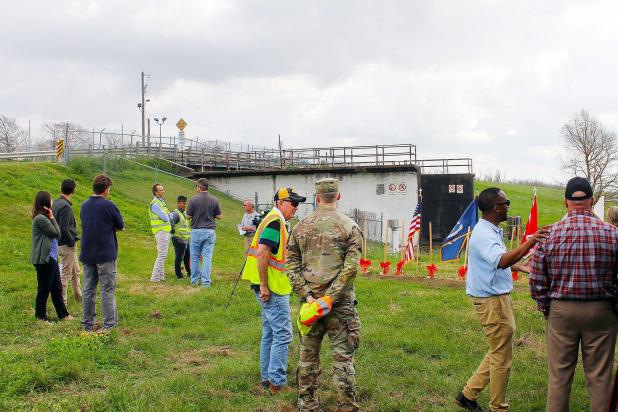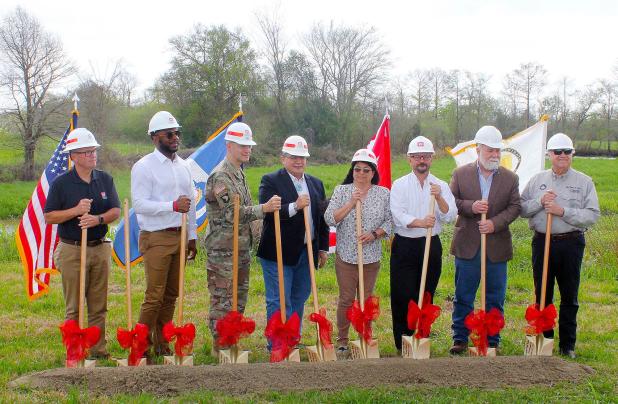
People gather following groundbreaking ceremonies for the Charenton Floodgate project. The $55.2 million project, expected to be completed in 2025, will replace the old Charenton Canal floodgate, which was built in 1949.
Banner-Tribune Photo

Officials with local and state government and the U.S. Army Corps of Engineers break ground Monday morning on a $55 million project to replace the Charenton Floodgate as part of the Atchafalaya Basin component of the Corps of Engineers’ Mississippi River and Tributaries Project. From left above are U.S. Army Corps of Engineers New Orleans District Deputy District Engineer Mark R. Wingate, acting Deputy District Engineer Durund Elzey, New Orleans District Commander Col. Cullen Jones, Office of the Assistant Secretary of the Army for Civil Works Principal Deputy Jaime Pinkham, Chitimacha Tribal Council Chairman Melissa Darden, St. Mary Parish President David Hanagriff, state Sen. Bret Allain and state Rep. Vincent “Vinny” St. Blanc.
Work officially begins on Charenton Canal flood gate
The nearly 75-year-old Charenton Floodgate, which stopped operation in the 1980s and was welded shut to maintain its structural integrity in 2011, will be replaced by early 2025 with a new floodgate as part of the U.S. Army Corps of Engineers’ Atchafalaya Basin flood control/Wax Lake levy system to help reduce flood risk for the people of South Louisiana.
Federal, state and local officials broke ground on the $55.2 million Charenton Floodgate project on Monday, Feb. 27. The new floodgate promises not only to help with flood risk, but also to open up that part of the basin and levy system for recreational use again, officials said.
“This is a great day for St. Mary Parish,” Parish President David Hanagriff said. “We’ve been having a lot of these great days. A lot has been accomplished over the last several years, and this is the next step and the next chapter in St. Mary Parish for providing flood control, and also recreation, which I love. I’ve lived here most of my life and I never remember going through these locks. All I remember is them being locked up, welded shut.”
Hanagriff said that during the flooding of 2016, there were discussions with Iberia Parish President Larry Richard about whether opening the gates would help alleviate some of the flooding.
“There wasn’t much of a difference in elevation, but there was a difference,” he said. “I think it was six to eight inches higher on this side versus that side. So again, the fact that we can open it up, in case, going both ways, is great for St. Mary Parish.”
Melissa Darden, chairman of the Chitimacha Tribal Council, agreed that the groundbreaking marked a great day.
“We’ve advocated for this to take place for many years now, not only to benefit the Chitimacha Tribe, the reservation, but all the surrounding communities,” she said. “And I’d like to thank everyone that made this possible because of collaboration. This opens up the recreation. Now we’ll be able to get across and get to Lake Chitimacha, which is our traditional waters, and the Atchafalaya.”
Jaime Pinkham, principal deputy in the Office of the Assistant Secretary of the Army for Civil Works, addressed those assembled for the groundbreaking with a saying in his native tongue.
“I wanted to begin my remarks in my native language to acknowledge the Chitimacha Tribe, the ancestral caretakers of this land, and what I said is, ‘The earth is part of my body. I belong to the land out of which I came. The earth is my mother,’” Pinkham said. “And I picked these words because they were spoken by a Nez Perce leader, when they were trying to force my tribe onto a reservation. It seemed fitting to acknowledge the tribe who remain on their ancestral homeland, because they have always been here.”
He also thanked all of the partners and neighbors who came together as guardians of the area.
“Alongside the tribe, you are the custodians of the future,” for the floodgate and surrounding area, he said. “I noticed that back in October of 2010, in a meeting hosted by the tribe, you all came together, and you wanted to bring your vision and your hopes for a future. Overwhelmingly, what you supported then is the direction that we see ourselves going forward today. And you partnered with the Army Corps of Engineers to arrive at a solution that would hold this floodgate to the promise that it made 74 years ago. Now today we’re going to raise this structure’s elevation to restore the appropriate flood level risk, while also restoring navigation for recreational, community and customary values.”
Pinkham said the Army Corps of Engineers worked with the public to find the intersection where its expertise met with the community vision.
“What I find hopeful in projects like this around the country is when we come together as an extended family — federal, tribal, state and local governments — and that we seem to accomplish the most when we’re able to work as partners,” Pinkham said.
A commitment of more than $20 billion in improvements along the Mississippi and its tributaries has prevented an estimated $2.7 trillion in damages since the Great Mississippi Flood of 1927, Pinkham said, a return of $131 for every dollar spent.
“A hundred thirty-one to one is impressive, but here at Charenton, this project underscores that our job is far from done,” he said. “Because harmonizing also means we have to deliver equity and provide balance in the system that responds to our most at-risk communities in a parish, a city or a tribe. For the Army, we hope to remain your partner in protecting the people you love, your neighbors, and the places that you call home.”
Col. Cullen Jones, New Orleans District commander for the Army Corps of Engineers, said the new floodgate will be increased in height to 11 feet, and will have an electric motor to open the floodgate, replacing the hand-crank system that opened and closed the original structure, which was built in 1949.
“That means that 50,000 citizens of St. Mary Parish will have decreased flood risk, but at the same time, as you heard, we’ll be able to open up this part of the levy for recreation and cultural use that we didn’t have since the ‘80s. That’s phenomenal. At the same time, we’re going to be able to remove the old floodgate, install the new system, a more modern, robust floodgate, and all that’s going to be at federal expense.”
Normal federal appropriations and disaster relief appropriations are paying for the project. Jones said the project should be completed by early 2025.
“As such I am excited to work with all of you as we make this project a reality and we continue to improve things for everyone in South Louisiana,” Jones said.
Hanagriff said the work couldn’t be done by just one agency, naming the Corps of Engineers, Pinkham, state Rep. Vincent St. Blanc, state Sen. Bret Allain, parish representatives, and tribal representatives, as well as the public.
“It takes a group,” he said. “This is not the end. This is just the beginning.”
